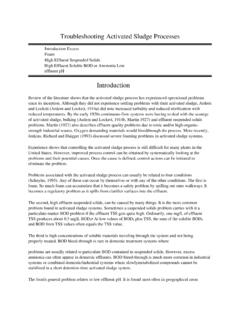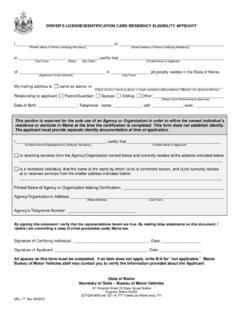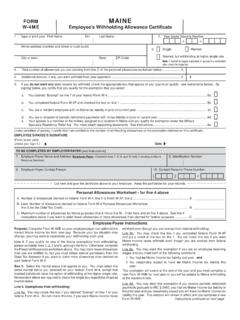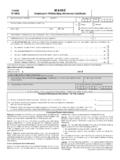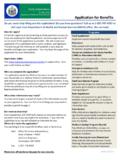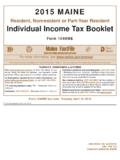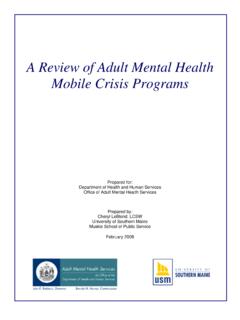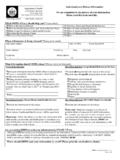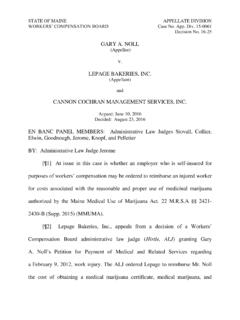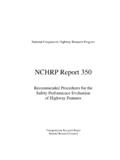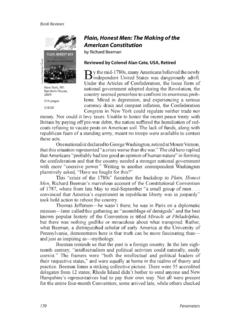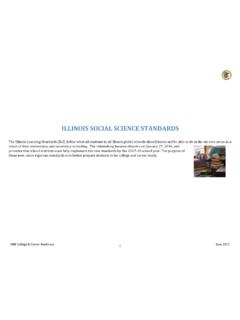Transcription of SOCIAL STUDIES - Maine.gov
1 05 -071 Chapter 132 - SOCIAL STUDIES Section Page 1 of 17 LEARNING RESULTS: PARAMETERS FOR ESSENTIAL INSTRUCTION 2007 Highlighted = maine Department of Education Regulation 131 Words in blue italics are defined in the glossary. SOCIAL STUDIES The primary purpose of SOCIAL STUDIES is to develop the ability to make informed and reasoned decisions for the public good as citizens of a culturally diverse, democratic society in an interdependent world (National Council of the SOCIAL STUDIES , 1994, ). The great architects of American public education, such as Thomas Jefferson, Horace Mann, and John Dewey, believed that every student must be well versed in our nation's history, the principles and practices which undergird citizenship, and the institutions that define our government.
2 Understandings of commerce and geography were critical to their thinking as well. In essence, Jefferson, Mann, and Dewey viewed the study of SOCIAL STUDIES as critical to the mission of public schools. Indeed, they would applaud the inclusion of a "responsible and involved citizen" in the Guiding Principles, as well as SOCIAL STUDIES as one of eight content areas in the Learning Results. A strong SOCIAL STUDIES education depends upon a clear understanding of its interrelated disciplines. Without knowledge of the geography and economics of earlier times, history offers only lists of people, events, and dates. Without knowledge of history, the institutions of American government and the dynamics of today's global economy are difficult to understand. Although SOCIAL STUDIES curricula vary in their breadth and depth, the SOCIAL STUDIES Standards reflect a focus on government, history, geography, and economics as the pillars of the content, with other disciplines within the SOCIAL sciences deemed important, but not essential.
3 Key Ideas in the SOCIAL STUDIES Standards: Understand - The word understand appears in performance indicators throughout the SOCIAL STUDIES Standards. It refers to a variety of different levels on Bloom s taxonomy and was used intentionally to serve as an umbrella term for the cognitive demand that is described by the descriptors beneath the performance indicators. Look to the descriptors to define the level of cognitive demand for student performance. Various -The SOCIAL STUDIES Standards refer to various" peoples, nations, regions of the world, historical eras, and enduring themes. School administrative units should develop a local curriculum that assists students in gaining a coherent, broad perspective on a variety of peoples, nations, regions, historical eras, and enduring themes. Major Enduring Themes - The term major enduring themes is used in several places in the SOCIAL STUDIES Standards.
4 This term refers to general topics or issues that have been relevant over a long period of time. Using a consistent set of themes can serve as a framework within which other concepts, topics, and facts can be organized. It can also help students make connections between events within and across historical eras, and use history to help make informed decisions. Four different lists of major themes are provided, and schools may select from them based on their judgment of which list will best serve the learning of their students. Eras School Administrative Units (SAU) should develop a coherent curriculum that provides students with a balanced exposure to the major eras of United States and World History. The term various eras in this document refers to those eras that are selected by an SAU to build a cohesive, balanced understanding. The eras , some of which overlap, include: 05 -071 Chapter 132 - SOCIAL STUDIES Section Page 2 of 17 LEARNING RESULTS: PARAMETERS FOR ESSENTIAL INSTRUCTION 2007 Highlighted = maine Department of Education Regulation 131 Words in blue italics are defined in the glossary.
5 Eras in United States History 1. The Americas to 1600 2. The Colonial Era, 1500-1754 3. The Revolutionary Era, 1754-1783 4. Nation Building, 1783-1815 5. The Expanding Nation, 1815-1850 6. Civil War and Reconstruction, 1850-1877 7. Development of the Industrial United States, 1865-1914 8. The Progressive Era, 1890-1914 9. Emergence of the United States as a World Power, 1890-1920 10. The 1920's: Prosperity and Problems 11. The Depression and The New Deal, 1929-1941 12. World War II and Postwar United States, 1939-1961 13. Contemporary United States, 1961-Present Eras in World History 1. The Emergence of Civilization to 1000 BC 2. The Classical Civilizations of the Mediterranean Basin, India, and China, 1000 BC 600 AD 3. The Expansion and Interaction of Civilizations, 600 AD 1450 AD 4. The Early Modern World, 1450 1800 5. The World in the Nineteenth Century 6. The World in the Contemporary Era maine Native Americans - The phrase maine Native Americans refers to the four maine Native American tribes the Penobscot, the Passamaquoddy, the Micmac, and the Maliseet.
6 Unity and Diversity - The Civics and Government, Economics, Geography, and History Standards all include performance indicators that address individual, cultural, international, and global connections. It will be up to the SAU to determine whether they use these performance indicators as an opportunity to integrate across the disciplines of the SOCIAL STUDIES or address them separately. In whatever manner the SAU addresses the instruction related to these performance indicators, it is critical that schools understand the importance of addressing the issues that both unify and divide. The following should help to provide clarity about the ideas related to unity and diversity that are contained in these performance indicators. Unity and Diversity - The concepts of "unity" and "diversity" apply to the Civics and Government, Economics, Geography, and History Standards in SOCIAL STUDIES . Unity and diversity have long been valued in the United States as foundations of the unique character of our society.
7 People throughout our nation's history have come from distinct and varied cultural, political, and religious backgrounds and perspectives. They have helped to shape and have participated in our national life based on the shared democratic values represented in our founding documents. We build common bonds of unity based on the democratic values, processes, and institutions that support our democratic way of life. At the same time we recognize the unique contributions, traditions, and perspectives of various groups and cultures. The concepts of unity and diversity also play a role in geography and economics. Diversity and unity influence the settlement and the economics of communities, regions, and nations. For example, in some cases a geographic factor such as a river serves as a resource that may bind a region, community, or a group of people of similar ethnic origins together. Economic systems or activities may unify a community or region; in other cases 05 -071 Chapter 132 - SOCIAL STUDIES Section Page 3 of 17 LEARNING RESULTS: PARAMETERS FOR ESSENTIAL INSTRUCTION 2007 Highlighted = maine Department of Education Regulation 131 Words in blue italics are defined in the glossary.
8 Economic influences may lead to economic diversity. The SOCIAL STUDIES Standards define the essential knowledge related to the concepts of unity and diversity under the broad umbrella of the performance indicators set forth at B3, C2, D2, and E2 which address Individual, Cultural, International, and Global Connections in civics and government, economics, geography, and history, respectively. Embedded Definition of the SOCIAL STUDIES Disciplines - The first performance indicator of each of these disciplines includes a descriptor that provides a definition of each of these disciplines that develops across the grade spans. This series of descriptors provides a developmentally appropriate picture of what is learned in the discipline, and should help to ensure that students will be able to distinguish among the disciplines of the SOCIAL STUDIES and what the individuals engaged in those areas of study do, and to understand which discipline or combinations of disciplines best address specific topics and issues.
9 OUTLINE OF SOCIAL STUDIES STANDARDS AND PERFORMANCE INDICATOR LABELS A. Applications of SOCIAL STUDIES Processes, Knowledge, and Skills 1. Researching and Developing Positions on Current SOCIAL STUDIES Issues 2. Making Decisions Using SOCIAL STUDIES Knowledge and Skills 3. Taking Action Using SOCIAL STUDIES Knowledge and Skills B. Civics and Government 1. Knowledge, Concepts, Themes, and Patterns of Civics/Government 2. Rights, Duties, Responsibilities, and Citizen Participation in Government 3. Individual, Cultural, International, and Global Connections in Civics and Government C. Economics 1. Economic Knowledge, Concepts, Themes, and Patterns 2. Individual, Cultural, International, and Global Connections in Economics D. Geography 1. Geographic Knowledge, Concepts, Themes, and Patterns 2. Individual, Cultural, International, and Global Connections in Geography E. History 1. Historical Knowledge, Concepts, Themes, and Patterns 2.
10 Individual, Cultural, International, and Global Connections in History 05 -071 Chapter 132 - SOCIAL STUDIES Section Page 4 of 17 LEARNING RESULTS: PARAMETERS FOR ESSENTIAL INSTRUCTION 2007 Highlighted = maine Department of Education Regulation 131 Words in blue italics are defined in the glossary. A. Applications of SOCIAL STUDIES Processes, Knowledge, and Skills: Students apply critical thinking, a research process, and discipline-based processes and knowledge from civics/government, economics, geography, and history in authentic contexts. A1 Researching and Developing Positions on Current SOCIAL STUDIES Issues Performance Indicators & Descriptors Pre-K-2 3-5 6-8 9-Diploma Students identify and investigate research questions related to SOCIAL STUDIES by locating, organizing, and sharing information.
